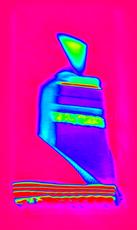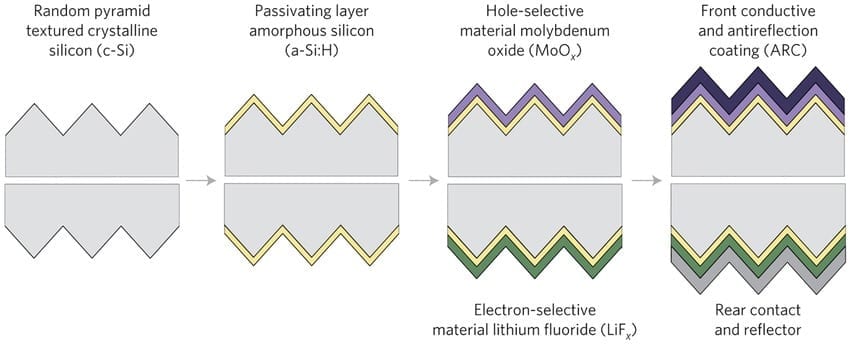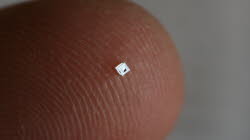
“One should consider that the production cost of this type of solar cell is several orders of magnitude lower than for conventional solar cells.”
The sharp X-ray vision of DESY‘s research light source PETRA III paves the way for a new technique to produce cheap, flexible and versatile double solar cells. The method developed by scientists from the Technical University of Denmark (DTU) in Roskilde can reliably produce efficient tandem plastic solar cells of many metres in length.
The scientists used a production process, where the different layers of a polymer (plastic) solar cell are coated from various solutions onto a flexible substrate. This way, the solar cell can be produced fast and cheap in a roll-to-roll process and in almost any desired length – up to several kilometers long single solar cell modules have already been manufactured. However, the energy harvesting efficiency of this type of solar cell is not very high. To increase the efficiency, a DTU team around Frederik C. Krebs stacked two such solar cells onto each other. Each of these absorbs a different part of the solar spectrum, so that the resulting tandem polymer solar cell converts more of the incoming sunlight into electric energy.
But the multilayer coating presents several new challenges, as Andreasen explained: “Lab studies have shown that already coated layers may be dissolved by the solvent from the following layer, causing complete failure of the solar cell.” To prevent redissolution of the first solar cell, the scientists added a carefully composed protective intermediate coating between the two solar cells. The protective coating contains a layer made of zinc oxide (ZnO) that is just 40 nanometres thick – about a thousand times thinner than a human hair.
To check shape and function of the protective coating and the other layers of the tandem solar cell, the scientists used the exceptionally sharp X-ray vision of DESY’s research light source PETRA III that can reveal finest details. “The solar cell structure is very delicate, consisting of twelve individual layers altogether. Imaging the complete structure is challenging,” explained co-author Juliane Reinhardt from DESY’s experimental station P06 where the investigations were made. “And the sample was just two by four microns in size.”
Still, with the brilliant X-ray beam from PETRA III, the researchers could peer into the layer structure in fine detail, using a technique called 3D ptychography. This method reconstructs the three-dimensional shape and chemistry of a sample from the way it diffracts the incoming X-rays. For a full 3D reconstruction a great number of overlapping X-ray diffraction images have to be recorded from all sides and angles. The advantage of ptychography is that it yields a higher resolution than would be possible with conventional X-ray imaging alone. And in contrast to electron microscopy, X-ray ptychography can also look deep inside the sample.
“With 3D ptychography, we were able to image the complete roll-to-roll coated tandem solar cell, showing, among other things, the integrity of the 40 nanometres thin zinc oxide layer in the protective coating that successfully preserved underlying layers from solution damage,” said DESY scientist Gerald Falkenberg, head of the experimental station P06. “These are the 3D ptychography measurements with the highest spatial resolution we have achieved so far. The results show that with the correct formulation of the intermediate layer, the underlying solar cell is protected from redissolution.”
The investigation paves the way to a possible industrial application of the new technique. “In a complex multilayer device like a polymer tandem solar cell, the device may fail in multiple ways,” Andreasen pointed out. “What we were able to see with 3D ptychography was that the preparation of the substrate electrode combines the good conductivity of a coarsely structured silver electrode with the good film forming ability of a conducting polymer that infiltrates the silver electrode and forms a smooth surface for the coating of the subsequent layers.” This is what allows the coating of very thin layers, at very high speeds, still forming contiguous layers, without pinholes.
Take me to the complete story . . .
The Latest on: Solar cell production
[google_news title=”” keyword=”solar cell production” num_posts=”10″ blurb_length=”0″ show_thumb=”left”]
via Google News
The Latest on: Solar cell production
- Middle East energy storage market set to skyrocket: Jinko Solar says its 3 GWh forecast underestimates its true potentialon May 9, 2024 at 3:15 am
Jinko Solar has established a vertically integrated production line in Saudi Arabia and is actively expanding its production capacity and solutions ...
- Cell prices fell, production schedules of module fell furtheron May 8, 2024 at 10:52 pm
Solar cell prices fell. The current price of high-efficiency PERC182 cells (efficiency of 23.2% and above) is 0.32-0.33 yuan/W; the price of PERC210 cells is about 0.35-0.36 yuan/W; the price of ...
- LONGi unveils heterojunction back-contact cell with record 27.3% conversion efficiencyon May 8, 2024 at 8:28 am
LONGi has set a new record for power conversion efficiency for silicon heterojunction back-contact (HBC) cells, of 27.3%.
- Global solar manufacturing sector now at 50% utilization rate, says IEAon May 8, 2024 at 8:14 am
The International Energy Agency (IEA) says that global solar cell and module manufacturing capacity grew by around 550 GW in 2023. It reports that around 80% of the global PV manufacturing industry is ...
- A low-energy process for high-performance solar cells could simplify the manufacturing processon May 8, 2024 at 7:39 am
Finding reliable, eco-friendly power sources is crucial as our world grapples with increasing energy needs and the urgent call to combat climate change. Solar energy offers one solution, with ...
- Low-energy process for high-performance solar cellson May 7, 2024 at 3:50 pm
Finding reliable, eco-friendly power sources is crucial as our world grapples with increasing energy needs and the urgent call to combat climate change. Solar energy offers one solution, with ...
- Accelerated declines in solar cell prices since late Marchon May 6, 2024 at 10:10 am
In a new weekly update for pv magazine, OPIS, a Dow Jones company, offers bite-sized analysis on solar PV module supply and price trends.
- Recent fires may impact production output for two leading solar panel manufacturerson May 6, 2024 at 5:42 am
Two solar panel manufacturers have experienced fires at factories in recent weeks that may affect production for months to come. JinkoSolar revealed that ...
- JinkoSolar gets grant for improved solar cell structure for enhanced photoelectric conversionon May 6, 2024 at 3:19 am
Revolutionize solar cell efficiency with JinkoSolar's patented design featuring pyramid structures and precise doping concentrations. Learn more about this innovative technology now!
- Researchers pioneer a low-energy process for high-performance solar cellson May 5, 2024 at 5:00 pm
They’re lightweight, flexible and can be applied as a spray or printed like ink. Perovskite solar cell production also has the potential for a smaller carbon footprint than silicon photovoltaics, ...
via Bing News










